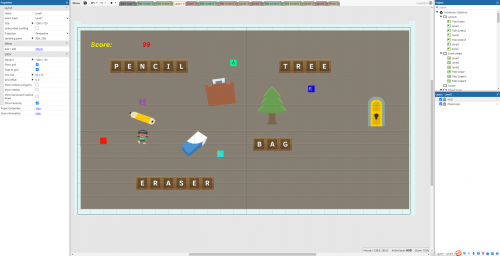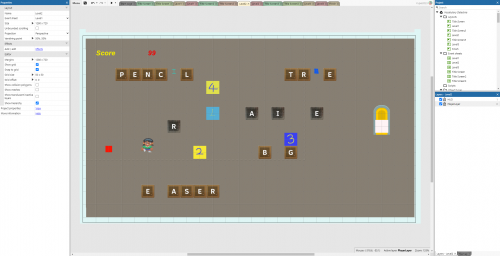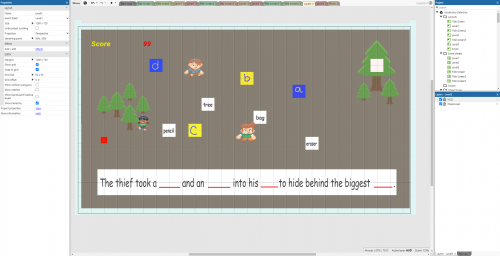Self-Reflection to Level 4: Vocabulary Detective: Digital Game Design Document & Construct 3
I finally finished the prototype of Vocabulary Detective, here is the Game link:https://yuepei.itch.io/vocabulary-detective

Level 1: match the graphics to the words

Level2: finish the word spellings

Level3: finish the sentence.

Game Overview
In this game, you will play as a detective to match the right graphics with the right words, to finish the word spellings, and to compose your sentences with the given words. The sentence you finally finished composing contains the clues of the hidden place of the thief, based on that, you will find the thief as a successive detective.
Learner/Player
The intended users are Grade 3 students in primary schools at Columbia, Missouri. They are 7-8 years-old girls. The boys will play another version of the game with different boy-player graphics. Other elements of the game will be the same. The kids are learning to spell new words related to learning tools. No need so much game experience for playing this game, only can use 4 different direction buttons to control the player to different directions when it is necessary. For the subject matter knowledge, the learners should know the right spellings of the common learning tools.
Subject Area
English Language Arts
Knowledge Domain
Declarative knowledge and rules-based knowledge(Kapp, 2012) are my game’s learning domains.
Declarative knowledge
- Matching: match the word to the picture which shows its meaning.
- Repetition: to find the right letters to finish the given words.
Rules-based knowledge
- Experience Consequences: Compose the correct English sentence with the given words.
Learning Objectives
Instructional objective: Grade 3rd students will be able to compose a simple English sentence by using the given words.
Supporting objectives:
- After playing the game, the players will be able to match the right graphics with the relative English words.
- After playing the game, the players will be able to correctly spell the given English words.
Game Goal
The overall goal of playing the game is to assist Grade 3rd students to learn and review common English words; practice composing English sentences. The players will try to use less time to remember the meaning of the words, familiarize the spellings, then try to use the words to compose sentences correctly. The more accuracy and the less time cost will gain extra points.
Game Description
This is a “Sokoban style” (pushing box) game. The player will experience three game levels. Firstly, to push the graphics to the relative English words, once a graphic matches to the correct word, the player gets the reward points. After playing, the player will learn or review the English words and remember their meanings. Second game level, the player will push the missing letter(s) to finish the word spellings they have seen in the first level. In this level, the players will get more chances to be familiar with the words. Third game level, based on understanding the meanings of the words and their spellings, the player will push the words to the right place(s) to finish an English sentence. The finished English sentence will tell the clues of the hidden place of the thief. The players will find the thief with understanding the meaning of the English sentence. Finally, the thief will be caught by the vocabulary detective with the help of police men and teachers.
Environment
It’s a half-realistic and half-fantastic game that takes place in an elementary school named G school (Fig.1).
Fig.1 Game Environment
The player will see a classroom with messy graphics and English words. A message from the teacher tells her that a thief stole items from the classrooms. The second classroom has English words with missing letters. The player will compose the English sentence in the third classroom and find the clue of the hidden location of the thief.
Story/Narrative
There is a story that helps players engage with the game. One dark night, a thief stole some valuable knowledge, made the items of instruction and learning in the classrooms a total mess in G School. The next morning, a Grade 3rd student asks to help teachers reorganize the teaching and learning items in the classrooms. The player will manipulate the four direction buttons on the keyboard to put everything back to the proper places. The player will see the graphics of the english words, English words, English words with missing letters, English sentences with missing words in different scenarios. The play will push the messy items which were disturbed by the thief to the original places, then find the lost items to report to police.
The purpose to keep the players moving forward is to save more time to report the missing items in the school to police. The faster the vocabulary detective finishes the matching, the quicker the police will understand the real loss in the campus to take action to catch the thief.
The climax of the story is using the right words to compose a correct sentence, which is based on the understanding of the meaning and usage of the words. The sentence is the clue to the thief’s hiding place. If the player understands the sentence correctly, he or she will help police find the thief more easily. The rising actions are being familiar with the meaning of the words in the first and second scenarios. The game helps foster students’ English vocabulary learning interests.
Characters
The main character is a Grade 3rd student, a vocabulary detective. Except for the main character, there is a thief hiding somewhere in G school, a teacher and a police officer who are searching for the thief.
The thief is a challenge in the game to arouse the passion of playing and learning. The teacher and the police officer are Non-player characters who are also very important components of this educational game. In real life, the kids are not recommended to face the criminals directly. The right way for them in this scenario is to report to adults or police officers.
Core Dynamic
Race to the finish, and Matching.
Gameplay
Core loop: The player will control a detective (sprite 1) to use the clues (English sentence) to resolve the crosswords puzzles and match the relative graphics, then use the words to compose an English sentence as soon as possible. Each correct match will add the score.
Action: The players will manipulate the four different directions buttons to control the spite to finish the tasks in the game.
Scoring, Reward, Assessment
Scoring: The initial score is 100 points. Each correct word matching will add 10 points, and each correct sentence matching will add 20 points. Meanwhile, each wrong matching will reduce 10 points.
Reward: The players will start from the game with a 120 seconds back counting timer. The left time will be calculated as extra points, each second equals to one point, to add to the score. The more proficient the player with matching, the higher points the player will get. The top 3 achievements will be recorded and will be viewable to other players.
Assessment : The game system will evaluate the players on their speed and accuracy when they successfully finish all the right matchings.
Gee Principles
- Identity – Clear goals and clear roles, games invite you to take on different roles and invite you to become different people and try new activities(Why Game Based Learning Will Make Your Child Smarter?, 2020).
In my game, I want to invite the players to take the role of a sort of superhero to help the police officer and school faculty to find the thief. Knowledge is powerful.
- Empowered Learners – learners must feel like what they do matters(Why Game Based Learning Will Make Your Child Smarter?, 2020). I hope the players can really use daily learning in their classrooms to resolve problems.
Description of Planned Construct 3 Game Implementation
I have been designing two letters and two objectives the letters should be pushed to by the player. If the right letter were pushed to, the system will add 10 points to the score, instead of the wrong letter being pushed to, then 10 points will be decreased from the total score. The same logic will be copied to more letters, graphics and word sprites.
There are some tutorials, resources I have been using
- Platformer game design tutorial: https://www.construct.net/en/tutorials/platformer-game-2329
- Top-down shooter game (score function) design tutorial: https://www.construct.net/en/tutorials/beginners-guide-construct-1
- Pushing box in construct 3 tutorial: How to make pushing box in Construct 2 & Construct 3 – YouTube
- Resource: Toon characters 1: Toon Characters 1 · Kenney
- Resource: Sokoban: Sokoban · Kenney
- Resource: Generic items(deceleration):Generic Items · Kenney
- Resource: Letter Tiles:Letter Tiles · Kenney
- Resource: Puzzle pack:Puzzle Pack · Kenney
Screenshots
Fig 2. Code event sheet
Fig 3. Play view
References
Tutorial
Sound and background music :https://www.youtube.com/watch?v=X6y0lTeOURE
Countdown timer: https://www.youtube.com/watch?v=V8BRbEJP7e8
Assets:
Audio:https://www.kenney.nl/assets/category:Audio?sort=update https://www.kenney.nl/assets/impact-sounds
Background music:https://freesound.org/
